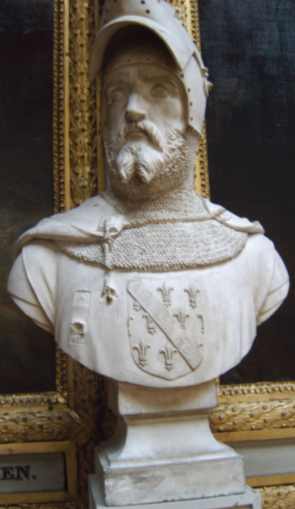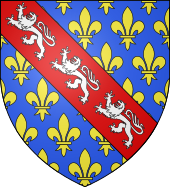James I, Count of La Marche facts for kids
Quick facts for kids
Jacques I
|
|
|---|---|
| Count of Ponthieu Count of La Marche | |
 |
|
| Native name | Jaques |
| Born | 1319 |
| Died | 6 April 1362 (aged 42–43) Lyon, Kingdom of France |
| Noble family | Bourbon |
| Spouse(s) | Jeanne of Châtillon |
| Issue | Isabelle de Bourbon, Pierre II, Count of La Marche, John I, Count of La Marche, Jacques de Bourbon |
| Father | Louis I, Duke of Bourbon |
| Mother | Mary of Avesnes |
James I of Bourbon (born 1319 – died 6 April 1362) was an important French noble. He was a "prince of royal blood," meaning he was closely related to the King of France. His father was Louis I, Duke of Bourbon, and his mother was Mary of Avesnes.
James held two important titles during his life. He was the Count of Ponthieu from 1351 to 1360. He was also the Count of La Marche from 1341 until he died.
Contents
James I and the Hundred Years' War

James I played a big part in the Hundred Years War, a long conflict between England and France. He led French armies in many battles and campaigns.
In 1347, James commanded an army near the Flemish border. He worked with a top military leader called a Marshal. They gathered French forces and attacked a Flemish camp at night. The Flemings fought back and then escaped across the border.
Later, in 1349, James became the Captain-General of Languedoc, a region in southern France. A truce, or temporary peace, had ended in 1349. War started again. James was given command of an army in early 1350. He quickly began talking with the English leader, Henry of Lancaster. They agreed to a new truce, first for Languedoc, then for all of France.
In 1354, James was given an even higher military role: Constable of France. This meant he was the chief commander of the French army.
In 1355, James helped plan new attacks against England. However, a new problem arose with Charles II of Navarre, another king who was causing trouble for France. Charles of Navarre was allied with England. James was part of a group that tried to make peace between the King of France and Charles. King John II of France finally agreed to forgive Charles.
But Charles of Navarre had already sailed to Normandy. When this news reached Paris, France had to prepare its defenses. James was put in charge of one of the main armies, stationed at Caen. He also helped negotiate a peace treaty with Charles of Navarre. This treaty was called the Treaty of Valognes.
Defending Toulouse
In late 1355, James went south to defend against an invasion by Edward, the Black Prince, the English heir. The Black Prince attacked further south than expected, not in the Garonne valley.
James and other French commanders rushed to Toulouse. They prepared the city for a siege. The Black Prince crossed rivers and marched close to Toulouse. James moved to Montauban to protect river crossings. The Black Prince continued eastward into undefended lands.
James and another commander, John I, Count of Armagnac, followed the English. They camped at Homps and thought about cutting off the English retreat. But no battle happened. The French commanders decided to pull back towards Toulouse.
During the English return, there were big disagreements among the French leaders. Armagnac wanted to avoid battle at all costs. He focused on defending cities and river crossings, leaving the countryside open to the English. This made the people of Languedoc very upset. James also wanted to fight.
The last chance to stop the English was at the Save River. But Armagnac broke the bridges and pulled back. The Black Prince crossed the river the next day and returned to English territory. The French defense was very unpopular. Even though James disagreed with Armagnac's plan, he still shared the blame.
Battle of Poitiers and Capture
James was tired of political arguments. In May 1356, he resigned his role as Constable. However, he still fought bravely at the Battle of Poitiers later that year.
During this battle, James was captured by the English. His ransom, a payment for his release, was set at 25,000 gold coins. He was eventually freed as part of the Treaty of Brétigny. This treaty also gave the region of Ponthieu to the English. James's brother, Peter, had died at Poitiers, so James became the Duke of La Marche.
Death in Battle
The peace promised by the treaty did not last long. English soldiers who were no longer fighting for the king became "Free Companies." These groups of mercenaries roamed the countryside, robbing people and demanding money from towns.
Soon after James returned from being a prisoner, King John II of France asked him to raise an army. James and another noble, Jean de Tancarville, were to stop these Free Companies. They gathered their army at Brignais.
James and his men did not expect the Free Companies to attack them openly. They were taken completely by surprise on the morning of 6 April 1362. In the battle that followed, the French army was defeated. James and his oldest son were both badly wounded and died from their injuries.
Family Life
In 1335, James I married Jeanne of Châtillon. She was the daughter of Hugh of Châtillon.
James and Jeanne had four children:
- Isabelle (1340–1371): She married Louis II, Viscount of Beaumont-au-Maine, in 1362. Later, she married Bouchard VII, Count of Vendôme, in 1364.
- Pierre II, Count of La Marche (1342–1362): He died in the same battle as his father.
- Jean I, Count of La Marche (1344–1393): He married Catherine of Vendome.
- Jacques de Bourbon, Baron de Thury (1346–1417): He married Marguerite around 1385.

